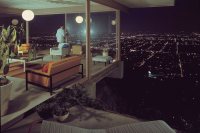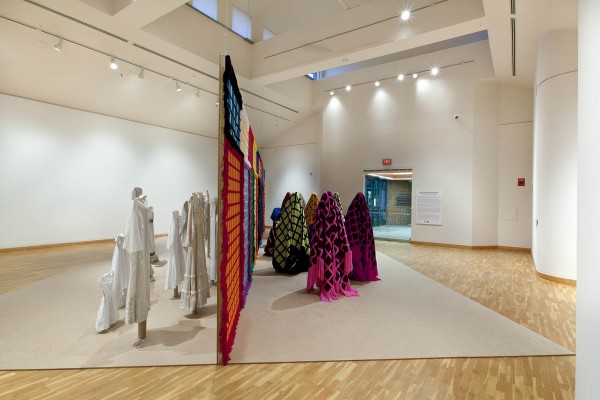
Lighting upgrade closes art museum for summer; new LEDs will slash electricity use

The Bates art museum is closed during summer 2013 for the replacement of its old halogen lights (shown in this image of Fransje Killaars’ 2013 exhibition “Color at the Center”) with energy-saving LEDs.
The Bates College Museum of Art is closed for the summer for the installation of a state-of-the-art (so to speak) lighting system.
New LED lighting will dramatically cut the museum’s electrical consumption, because LEDs not only use less electricity than the museum’s current halogen lights, but run much cooler, reducing the air conditioning burden.
Other benefits will directly affect the experience of viewing art in the 27-year-old museum, explains director Dan Mills. For one, the new fixtures afford more flexibility in aiming and shaping the projected light. “We’ll have a menu of lighting solutions that we can apply to our artworks and exhibitions,” Mills says.
The new system will also protect artwork. For one thing, the LEDs don’t emit ultraviolet light, which can degrade artwork. They can be dimmed without changing the color of the light, which will enable the museum to display light-sensitive works more effectively under reduced lighting.
A far cry from the feeble red light-emitting diodes of the 1970s and ’80s, today’s LEDs “are a technology that has evolved significantly in recent years,” Mills says.
Totaling more than 100 fixtures, the new lights will be installed in exhibition areas on both floors of the museum, located in Bates’ Olin Arts Center, on Russell Street.
The system will cut electrical consumption by 60 percent just for running the lights, with additional savings in climate control. Though LEDs cost more up front than other lighting systems, they pay for themselves relatively quickly through energy conservation.
The LED units are made by Lighting Services Inc. of Stony Point, N.Y.
The units are not base fixtures with replaceable bulbs like halogen or incandescent lights, but instead come as single integrated pieces. They have a life expectancy of at least 17 years, Mills says. Such longevity will spare museum staff considerable trouble. In the main-floor gallery alone, bulbs in the old system failed at the rate of 10 or so per exhibition, Mills explains.
“This meant we’d have to rent a hydraulic lift a few times per show, and staff would have to go up to replace lamps. With the new system, we’ll only need the lift once per exhibition,” to aim and adjust the fixtures.
The dimming controls are “computer-controlled and very sophisticated,” he adds, “allowing us to set and closely manage manage light levels.”
The installation will require rewiring and structural work in the ceilings. At the same time, floor and wall surfaces will be replaced.
The work is estimated to total some $221,000, with the lighting work accounting for $190,000.
The museum reopens Sept. 13 with the exhibition Redefining the Multiple: 13 Japanese Printmakers.




